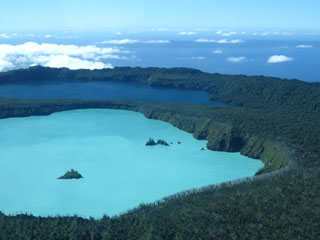Report on Ambae (Vanuatu) — May 2006
Bulletin of the Global Volcanism Network, vol. 31, no. 5 (May 2006)
Managing Editor: Richard Wunderman.
Ambae (Vanuatu) During May-June 2006, Lake Voui's water rapidly turns from blue to red
Please cite this report as:
Global Volcanism Program, 2006. Report on Ambae (Vanuatu) (Wunderman, R., ed.). Bulletin of the Global Volcanism Network, 31:5. Smithsonian Institution. https://doi.org/10.5479/si.GVP.BGVN200605-257030
Ambae
Vanuatu
15.389°S, 167.835°E; summit elev. 1496 m
All times are local (unless otherwise noted)
Alain Bernard reported that Lake Voui in Aoba-Ambae volcano (BGVN 31:01) was undergoing a spectacular change in its color?the previously aqua-colored lake was turning red (figure 27).
 |
Figure 27. Lake Voui at Aoba as seen from the air on 28 May (top) and 3 June 2006 (bottom). Images courtesy of Esline Garaebiti (top) and Philippe Métois (bottom). |
Images of a pale reddish Lake Voui were obtained by Esline Garaebiti, who flew over the volcano 28 May 2006. Philippe Métois, who flew over on 3 June 2006, photographed a blood-red lake. These photos were are posted on the CVL website along with recent ASTER temperature data. This color change was tentatively attributed to a rapid shift in the lake water's redox state. The change might be linked to the ratio of SO2/H2S in the hydrothermal fluids.
Geological Summary. The island of Ambae, also known as Aoba, is a massive 2,500 km3 basaltic shield that is the most voluminous volcano of the New Hebrides archipelago. A pronounced NE-SW-trending rift zone with numerous scoria cones gives the 16 x 38 km island an elongated form. A broad pyroclastic cone containing three crater lakes (Manaro Ngoru, Voui, and Manaro Lakua) is located at the summit within the youngest of at least two nested calderas, the largest of which is 6 km in diameter. That large central edifice is also called Manaro Voui or Lombenben volcano. Post-caldera explosive eruptions formed the summit craters about 360 years ago. A tuff cone was constructed within Lake Voui (or Vui) about 60 years later. The latest known flank eruption, about 300 years ago, destroyed the population of the Nduindui area near the western coast.
Information Contacts: Alain Bernard, IAVCEI Commission on Volcanic Lakes (CVL), Université Libre de Bruxelles (ULB), CP160/02, avenue F.D. Roosevelt 50, Brussels, Belgium (URL: http://www.ulb.ac.be/sciences/cvl/aoba/Ambae1.html, http://www.ulb.ac.be/sciences/cvl/multispectral/multispectral2.htm); Esline Garaebiti, Department of Geology, Mines, and Water Resources (DGMWR), Port-Vila, Vanuatu; Philippe Métois, World of Wonders.

